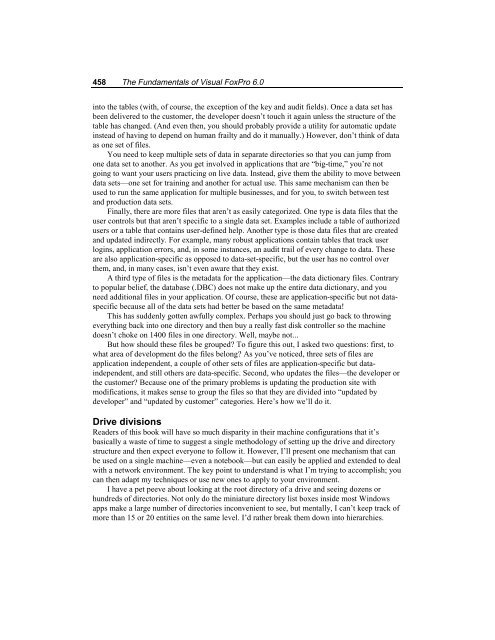Chapter 16 Customizing Your Development ... - dFPUG-Portal
Chapter 16 Customizing Your Development ... - dFPUG-Portal
Chapter 16 Customizing Your Development ... - dFPUG-Portal
Create successful ePaper yourself
Turn your PDF publications into a flip-book with our unique Google optimized e-Paper software.
458 The Fundamentals of Visual FoxPro 6.0<br />
into the tables (with, of course, the exception of the key and audit fields). Once a data set has<br />
been delivered to the customer, the developer doesn’t touch it again unless the structure of the<br />
table has changed. (And even then, you should probably provide a utility for automatic update<br />
instead of having to depend on human frailty and do it manually.) However, don’t think of data<br />
as one set of files.<br />
You need to keep multiple sets of data in separate directories so that you can jump from<br />
one data set to another. As you get involved in applications that are “big-time,” you’re not<br />
going to want your users practicing on live data. Instead, give them the ability to move between<br />
data sets—one set for training and another for actual use. This same mechanism can then be<br />
used to run the same application for multiple businesses, and for you, to switch between test<br />
and production data sets.<br />
Finally, there are more files that aren’t as easily categorized. One type is data files that the<br />
user controls but that aren’t specific to a single data set. Examples include a table of authorized<br />
users or a table that contains user-defined help. Another type is those data files that are created<br />
and updated indirectly. For example, many robust applications contain tables that track user<br />
logins, application errors, and, in some instances, an audit trail of every change to data. These<br />
are also application-specific as opposed to data-set-specific, but the user has no control over<br />
them, and, in many cases, isn’t even aware that they exist.<br />
A third type of files is the metadata for the application—the data dictionary files. Contrary<br />
to popular belief, the database (.DBC) does not make up the entire data dictionary, and you<br />
need additional files in your application. Of course, these are application-specific but not dataspecific<br />
because all of the data sets had better be based on the same metadata!<br />
This has suddenly gotten awfully complex. Perhaps you should just go back to throwing<br />
everything back into one directory and then buy a really fast disk controller so the machine<br />
doesn’t choke on 1400 files in one directory. Well, maybe not...<br />
But how should these files be grouped? To figure this out, I asked two questions: first, to<br />
what area of development do the files belong? As you’ve noticed, three sets of files are<br />
application independent, a couple of other sets of files are application-specific but dataindependent,<br />
and still others are data-specific. Second, who updates the files—the developer or<br />
the customer? Because one of the primary problems is updating the production site with<br />
modifications, it makes sense to group the files so that they are divided into “updated by<br />
developer” and “updated by customer” categories. Here’s how we’ll do it.<br />
Drive divisions<br />
Readers of this book will have so much disparity in their machine configurations that it’s<br />
basically a waste of time to suggest a single methodology of setting up the drive and directory<br />
structure and then expect everyone to follow it. However, I’ll present one mechanism that can<br />
be used on a single machine—even a notebook—but can easily be applied and extended to deal<br />
with a network environment. The key point to understand is what I’m trying to accomplish; you<br />
can then adapt my techniques or use new ones to apply to your environment.<br />
I have a pet peeve about looking at the root directory of a drive and seeing dozens or<br />
hundreds of directories. Not only do the miniature directory list boxes inside most Windows<br />
apps make a large number of directories inconvenient to see, but mentally, I can’t keep track of<br />
more than 15 or 20 entities on the same level. I’d rather break them down into hierarchies.

















